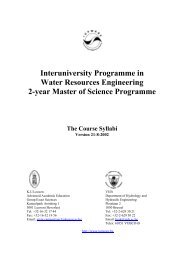CFHT operating manual - Homepage Usask
CFHT operating manual - Homepage Usask
CFHT operating manual - Homepage Usask
You also want an ePaper? Increase the reach of your titles
YUMPU automatically turns print PDFs into web optimized ePapers that Google loves.
ESPaDOnS: control software and user interface http://webast.ast.obs-mip.fr/magnetisme/espadons_new/control.html<br />
ESPaDOnS<br />
control software and user interface<br />
Control software<br />
Instrument control is operated through the cfht ’director’ environment. Within this environment, line commands are typed and<br />
dispatched to the four agents, each controlling one specific instrument module.<br />
The cassegrain agent controls the cassegrain module and<br />
associated motions, lamps and sensors. This includes in<br />
particular moving the atmospheric dispersion corrector prisms<br />
(commands adc, adc1 and adc2), the calibration wheel<br />
(command calibwh), the guider density wheel (command<br />
denswh), the halfwave rhombs (commands rhomb1 and<br />
rhomb2), the wollaston slide (command wedwol) and the<br />
fabry-perot wheel (command fabpero). It also involves<br />
switching on and off the flat field and thorium lamps in the<br />
calibration box and tuning their fluxes (commands flat, thor,<br />
fluxred, fluxblue) and reading the two temperature sensors<br />
(commands temppol and tempcb). It can also display the status<br />
of the cassegrain unit, as shown in the image on the right.<br />
The spectrograph agent controls the spectrograph unit and<br />
associated motors, lamps and sensors. In particular, it operates<br />
the camera drive and hartmann mask for focussing the<br />
spectrograph (commands camfocus and hartmann), the slicer<br />
rotation and associated motions for setting the spectrograph<br />
configuration (commands slicer, bench and dekker) and the<br />
slicer lamp drive (only used for alignment purposes, command<br />
lamp). It can also set the slicer lamp on or off (command halogen), put the exposure meter on or off (command expometer),<br />
open or close the exposure meter shutter (command exposhutter), read the 4 temperature, the pressure and hygrometer sensors<br />
(commands tmp1, tmp2, tmp3, tmp4, pressure, hygrometry) and launch the associated graphical tools (commands hskgui for<br />
displaying the sensors values and apdgui for displaying the exposure meter graphs).<br />
The guider agent operates the guiding camera and offers all usual functionalities, among which acquiring and displaying images<br />
from the guiding camera (commands acquire and visu), changing the position and size of the image (command winsize),<br />
updating the zone on which guiding is active (command gzone), computing the relative position of the guiding star with respect<br />
to the centre of the guiding zone and send corrections to the telescope control system (command autoguide). It also provides the<br />
observer with a number of byproducts, like for instance a graphical window displaying the magnitude and width of the guiding<br />
star as a function of time (command gapgui).<br />
The detcom agent operates the main ccd detector as well as the spectrograph shutter. It offers the observer all usual explosure<br />
handling utilities, like setting the exposure type and time (commands etype and etime), running exposures (command go) and<br />
checking the ccd temperature (command temp).<br />
Individual commands can be chained within shell scripts to automatically run series of operations that require a large number<br />
of low level tasks. With such scripts, observing sessions can be automated quite easily, provided adequate procedures have been<br />
designed for the program being carried out.<br />
Graphical user interface<br />
The alternate option for <strong>operating</strong> the instrument is the graphical user interface. It essentially consists in a graphical interface<br />
with buttons, checkboxes and popup menus offering all commands mentioned above with a much more intuitive approach.<br />
While checkboxes and popup menus set up parameters, buttons run scripts executing sequences of individual commands that<br />
depend on the selected options.<br />
The design of the graphical user interface is finished and is presentely being implemented at cfht.<br />
1 of 2 08/07/04 11:31 PM

















